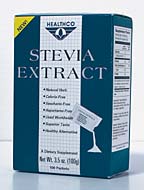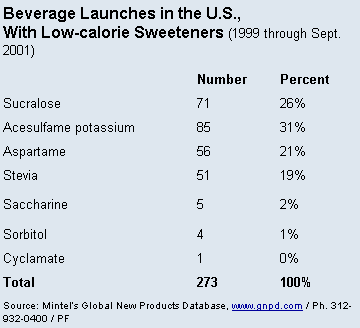
Aspartame and Acesulfame potassium
A sweetener that its manufacturers claim to be some 180 times sweeter than sugar, aspartame was approved for food use in 1981. Aspartame is used in products such as beverages, cereals, desserts, dairy and chewing gum. A look at the GNPD reveals products such as HyVee's, West De Moines, Iowa, Water Coolers, flavored sparkling beverages; Hansen's, Corona, Calif., line of diet soda carbonated soft drinks; and Genuardi's Family Markets, Norristown, Penn., nonfat raspberry yogurt, use aspartame as a sweetener.Acesulfame potassium, also known as ace-k, was approved by the FDA in 1998 for use in beverages. Ace-k is 200 times sweeter than sugar, is stable at baking temperatures and usually is mixed with other low-calorie sweeteners to enhance the product's flavor profile. Well-known products using ace-k include Kraft Foods', Glenview, Ill., Sugar-Free International Coffees and Crystal Light products. Acesulfame potassium is considered a relatively new product and is meeting heavy competition from previously established sweeteners.
Thus, it is no surprise that activity has been flat in 1999, 2000 and 2001. What small number of items have been introduced are in the beverages, candy, desserts and weight control products sectors. Pepsi One, Purchase, N.Y., and Clearly Canadian's, Vancouver, Fitness Water, a fortified product, use this ingredient.
The Stability of Sucralose
Sucralose was approved by the FDA for tabletop use in 1998 and for general use in 1999. A high-intensity sweetener 600 times as sweet as sugar, sucralose withstands baking temperatures and is considered highly stable in industrial processing. New product activity involving this ingredient was up 179% in 2000 and continues to grow.
Beverages such as Ocean Spray Cranberries', Lakeville-Middleboro, Mass., reformulated Light Cranberry Juices and Campbell Soup Company's, Camden, N.J., diet versions of V8 Splash are well-known products containing this product. “Because sucralose is a high-intensity sweetener, it is used with a low-calorie bulking agent, such as polydextrose, to add back solids and bulk,” reads the report. “For example, Atkins Nutrition's, Happauge, N.Y., Breakfast Bars use polydextrose with sucralose while Richardson Labs', Boca Raton, Fla., Tru Soy product is made with maltodextrin, sugar, maltitol, dextrose and sucralose.” The summary suggests that because all high-intensity sweeteners require the addition of bulking agents, except in fluids, this “represents a technological challenge in product formulation and may be part of the reason why development in some categories is a bit slow.”
Other Sweeteners
An array of products containing sweeteners such as xylitol, mannitol, lactitol and polyols can be found when perusing the GNPD. For example, xylitol, which has been utilized in foods since the 1960s, is known for its role in reducing tooth decay. It is often used in gum, gumdrops, hard candy and in items such as chewable vitamins. Xylitol is found in Nabisco/Kraft's, Parsippany, N.J., Carefree Koolerz Gum.
Mannitol has a cooling effect and about 60% of sugar's sweetness. Its role is to inhibit crystal formations in sorbitol-based confections, and it most often is used in sugar-free gum, and chewable vitamins, as well as in sugar-free chocolate coatings for ice cream. While there is not a lot of activity involving mannitol, recent products include Wrigley's, Chicago, Orbit Sugarfree gum, and the company's Velamints.

“Polyols are being used in the chewing gum segment, where their cooling mouthfeel and reduced cavity-causing effects are a potent combination of benefits,” reads the report. William W. Wrigley Jr. Co. is developing a line of Crest chewing gum with Procter & Gamble, Cincinatti.
Sugar-Free Products
Isomalt has been used in the U.S. since the early 1980s in items such as hard candies, throat drops, lozenges and lollipops. It also can be applied in flavored beverages such as coffee and chocolate, and baked goods. Isomalt helps mask the bitter aftertaste of certain high-intensity sweeteners and can be found in products such as Russell Stover Candies', Kansas City, sugar-free candies and Simply Lite Food's, Port Washington, N.Y., Sweet 'n Low Peanut Butter Wafer Bars. “The growth of the number of new products including isomalt points to sugar-free as being a trend to continue to watch,” indicates the report.New Sweeteners
Manufacturers will continue to strive to satisfy consumer demand for foods and beverages low in sugar and calories. There will be growth in the bakery, snack, dessert and ice cream sectors, and increased demand for sweeteners that can withstand rigorous manufacturing conditions.
A thank-you goes to Mintel Consumer Intelligence: U.S. Ingredients Report, which provided some information for this article: 312-943-5250; www.consumer.mintel.com
Sidebar: Great Expectations
Increased use of high-intensity and conventional sweetener combinations in order to achieve a balanced taste profile, with lower calories.Increased use of polyols, as manufacturers become more familiar with their unique properties, especially in bakery and candy applications.
A broader array of products with a variety of sweetness intensities. In both Europe and Asia, there are a number of lightly sweetened options such as flavored waters, sodas that are not sticky sweet, and bitter or aromatic teas.
Amy Stockwell, Principal, Analytech Associates, FdIngred@aol.com